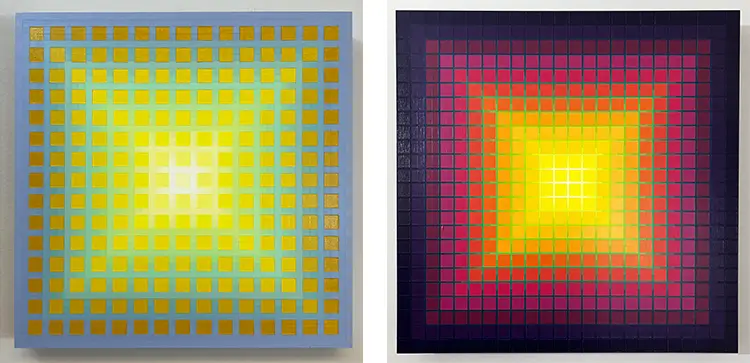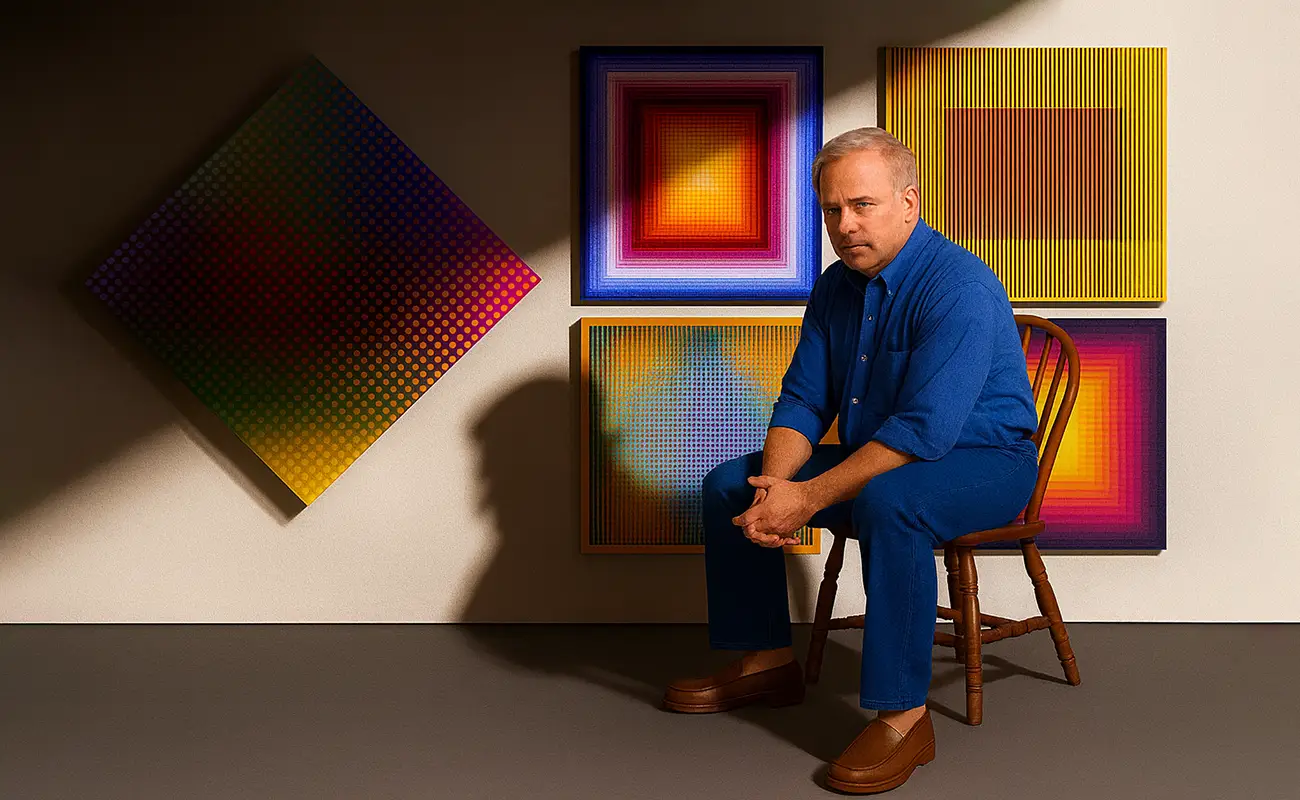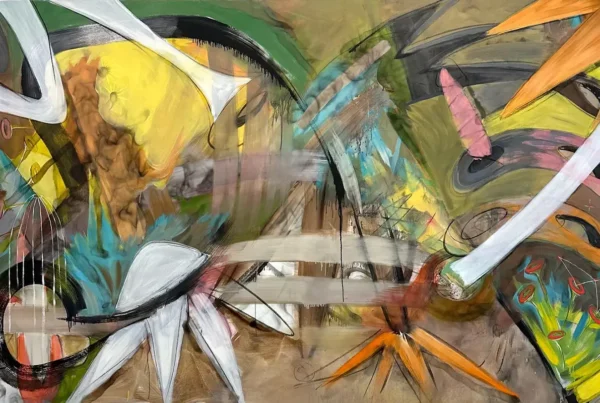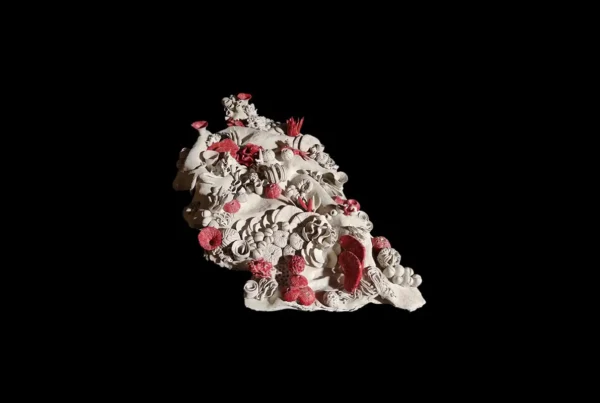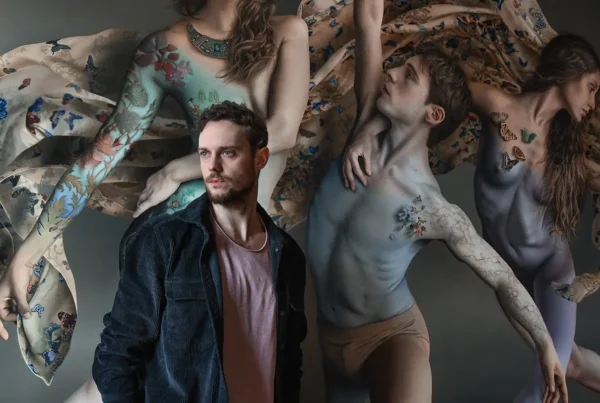“The realization of a concept becomes artistic accomplishment when a tangible product is brought to fruition through physical endeavor.”
Exploring Perception Through Precision
In an era where digital abstraction dominates, Mark Vogel offers a refreshingly tactile engagement with geometric precision and optical experimentation. Known for his distinct use of hard-edge painting and chromatic interplay, Vogel defines his practice as a contemporary continuation of the Op Art movement. His work investigates how color relationships influence perception, memory, and spatial experience. Every line, shape, and hue is selected to challenge the viewer’s eye and mind, constructing intricate illusions that seemingly shimmer, pulse, or shift. Rather than aiming to replicate reality, Vogel’s compositions explore how reality can be reshaped through controlled visual stimuli.
At the heart of Vogel’s process is his role as a colorist. His primary fascination lies in the dynamic interplay of hues, particularly how adjacent tones can interact to produce unexpected effects. His paintings often hinge on the concept of simultaneous contrast, where the perception of one color alters depending on its surrounding tones. This concept becomes vividly clear in his “Asterism” pieces, where unseen visual elements emerge solely through color interaction. The term “Asterism,” borrowed from the world of gemology, describes the illusion of an “X” that materializes not through paint, but through the precise orchestration of light and dark transitions.
Vogel’s approach is deeply rooted in structure, combining analytical thinking with creative intent. His “Interreticulation Series,” for example, engages with grids of intersecting lines layered over geometric foundations, creating visual friction and complexity. In contrast, his “Pointillism Grid Series” draws on color theory by arranging small, distinct squares that blend optically into cohesive visual fields. Across all series, Vogel remains committed to creating physical artworks through a hands-on process, emphasizing craftsmanship, patience, and human precision—an artistic stance that separates his practice from the increasingly digital and algorithmic methods that dominate much of today’s art discourse.
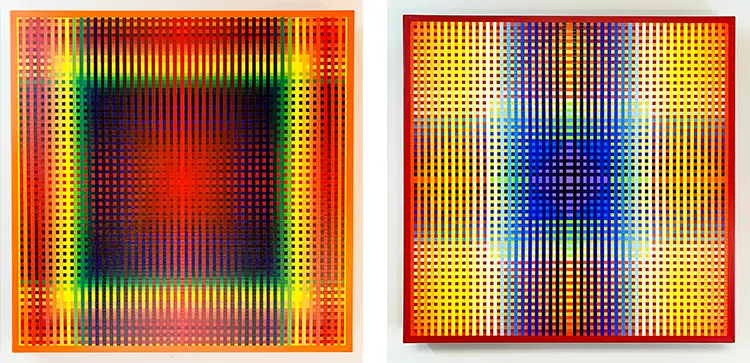
Mark Vogel: A Return to Colorful Foundations
Mark Vogel’s journey into the world of art has been anything but linear, marked by an early love for painting, a detour into the corporate side of advertising, and a rekindled creative spark later in life. He holds a B.A. in Art and once painted figural works influenced by a wide array of masters, from Edward Hopper to Claude Monet. However, financial stability eventually took precedence, leading him into agency management. Years passed, and it wasn’t until his 60th birthday that Vogel made a decisive return to artistic creation—this time with a sharpened focus on color as the sole subject. It wasn’t nostalgia but a deep intellectual and sensory interest that called him back.
Transitioning from figurative painting to abstract geometry wasn’t merely a stylistic shift; it was a philosophical one. Vogel’s current work falls within the lineage of Op Art, with extensions into Concrete Art, Reductive Art, and Post-Painterly Abstraction. What unites these labels in Vogel’s practice is a desire to strip away narrative and symbolism, leaving only the essential components: shape, line, and color. He builds visual depth not through literal perspective, but through layered hues and rhythmic structures that appear to move or flicker depending on the viewer’s gaze. His art is not passive. It asks the eyes to work.
What defines Vogel’s style beyond color theory is the insistence on craftsmanship. His methods require acute hand-eye coordination, an exacting application of tape, and an intense understanding of the materiality of paint. Each work is the result of numerous decisions and revisions, guided not by digital tools or random generation but by what he refers to as “the direct involvement of the artist in the final product.” For Vogel, physical effort is not optional—it is integral. A painting must exist as an embodiment of both thought and touch, a tangible artifact shaped through real-world labor, not automated processes.
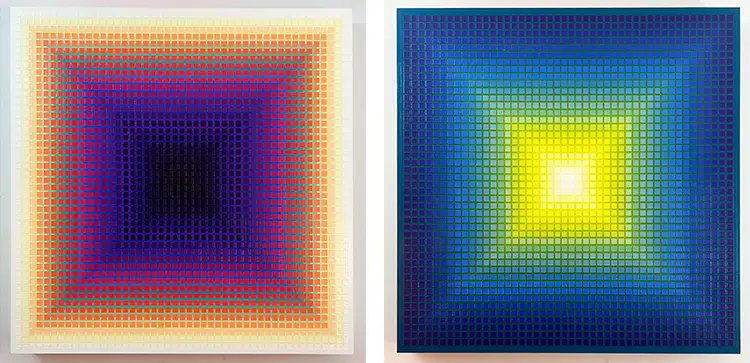
The Science of Seeing
Color for Vogel is not a decorative choice, but a structural element that underpins every aspect of his compositions. Central to this exploration is his use of the Munsell Color System, a scientifically developed framework for understanding color based on three attributes: hue, value, and chroma. Vogel has adapted this system into his workflow, translating digital RGB values into Munsell coordinates through a self-designed program. This technical foundation allows him to predict how colors will interact across a composition before the first brushstroke is laid. Each color is tested on 2” by 4” cards, labeled, sorted, and archived according to their properties—creating a comprehensive library of hue studies that supports his evolving practice.
While technology informs his planning phase, Vogel’s actual painting process is firmly rooted in analog techniques. He paints primarily on gessoed wood and MDF panels, preferring these rigid surfaces for their resistance to tape bleed and their ability to maintain crisp, clean edges. Adhesive tape is used in varying widths to mask off sections of color, and after each layer is completed, the tape is peeled back in what he calls the “Great Reveal.” This moment, when the final relationships of shape and hue are unveiled, carries both anticipation and discovery, highlighting the controlled unpredictability inherent in his process.
Among Vogel’s most significant works is “November 4 2020,” a painting that serves as a personal and technical milestone. This 24” by 24” piece, part of the Asterism Series, was the first to successfully achieve the visual illusions he had long pursued. Using fluid acrylics on a cradled wood panel, the work manipulates simultaneous contrast to create an “X” effect that only exists in the viewer’s perception. The piece was accepted into multiple juried exhibitions, including the prestigious Art of the State show at the State Museum of Pennsylvania. More than a visual experiment, it validated his theories about optical effects and marked a turning point in his confidence as an artist.
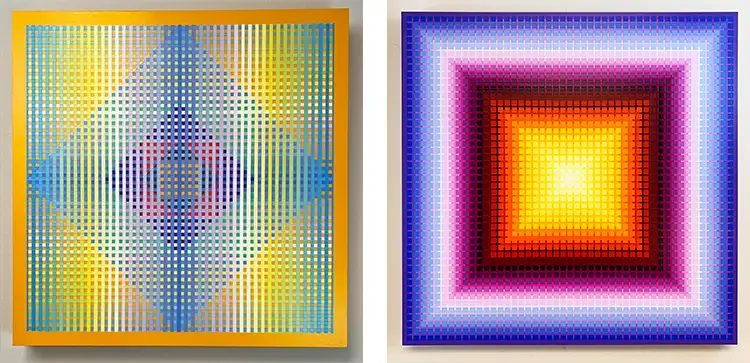
Mark Vogel: Building a Monument to Color
Vogel’s studio routine blends the methodical with the intuitive. A former advertising professional, he brings an organizational rigor to his painting process that mirrors campaign planning more than traditional art-making. Each work is labeled with codes indicating its layers, positions, and mixing formulas—effectively transforming the act of painting into a choreographed sequence. These codes serve not only as logistical aids but also as historical records, documenting the evolution of each piece from concept to completion. His notebooks, color cards, and digital sketches form an archive that supports the iterative nature of his work.
Although his current pieces remain relatively small in scale—primarily 6”, 12”, or 24” squares—Vogel’s ambitions extend far beyond the limits of his current studio. He envisions constructing a monumental work composed of multiple square panels arranged into a 12-foot expanse. This larger format would not simply scale up his designs, but fundamentally transform the viewer’s engagement. He’s particularly interested in how a physically immersive experience can amplify the psychological effects of color interaction, similar to what artists like Mark Rothko and Barnett Newman achieved in their own large-scale canvases. The possibility of enveloping viewers in an orchestrated field of shifting hues represents a significant next step in his creative evolution.
Vogel sees color as both a visual and emotional force, capable of generating experiences that cannot be replicated through language or logic. He often reflects on the staggering capacity of the human eye to distinguish over one million colors—a number that serves not to overwhelm, but to energize him. Within each composition lies a network of decisions guided by sensitivity, precision, and an unending curiosity about perception. Though he entered this chapter of his life later than many, Vogel embraces the urgency and richness that come with delayed fulfillment. With every painting, he reasserts his belief in the artist’s touch as both a method and a message—reminding us that seeing, truly seeing, is an act that begins with attention and ends in wonder.
